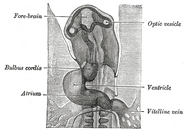Assessment |
Biopsychology |
Comparative |
Cognitive |
Developmental |
Language |
Individual differences |
Personality |
Philosophy |
Social |
Methods |
Statistics |
Clinical |
Educational |
Industrial |
Professional items |
World psychology |
Biological: Behavioural genetics · Evolutionary psychology · Neuroanatomy · Neurochemistry · Neuroendocrinology · Neuroscience · Psychoneuroimmunology · Physiological Psychology · Psychopharmacology (Index, Outline)
| Embryology: Optic vesicles | ||
|---|---|---|
| Transverse section of head of chick embryo of forty-eight hours’ incubation. (Optic vesicle labeled at lower right.) | ||
| Human embryo about fifteen days old. Brain and heart represented from right side. Digestive tube and yolk sac in median section. (Optic vesicle labeled at center top.) | ||
| Latin | v. ophthalmica | |
| Gray's | subject #224 1001 | |
| System | ||
| Carnegie stage | 11 | |
| Days | {{{Days}}} | |
| Precursor | ||
| Gives rise to | ||
| MeSH | [1] | |
| Dorlands/Elsevier | v_07/12855707 | |
The eyes begin to develop as a pair of diverticula from the lateral aspects of the forebrain. These diverticula make their appearance before the closure of the anterior end of the neural tube; after the closure of the tube they are known as the optic vesicles.
They project toward the sides of the head, and the peripheral part of each expands to form a hollow bulb, while the proximal part remains narrow and constitutes the optic stalk.
Additional images[]
External links[]
This article was originally based on an entry from a public domain edition of Gray's Anatomy. As such, some of the information contained herein may be outdated. Please edit the article if this is the case, and feel free to remove this notice when it is no longer relevant.
Neural development/Neurulation - Neurula - Neural folds - Neural groove - Neural tube - Neural crest - Neuromere (Rhombomere) - Notochord - Neural plate
Eye development - Optic vesicles - Optic stalk - Optic cup - Auditory vesicle - Auditory pit
| This page uses Creative Commons Licensed content from Wikipedia (view authors). |

